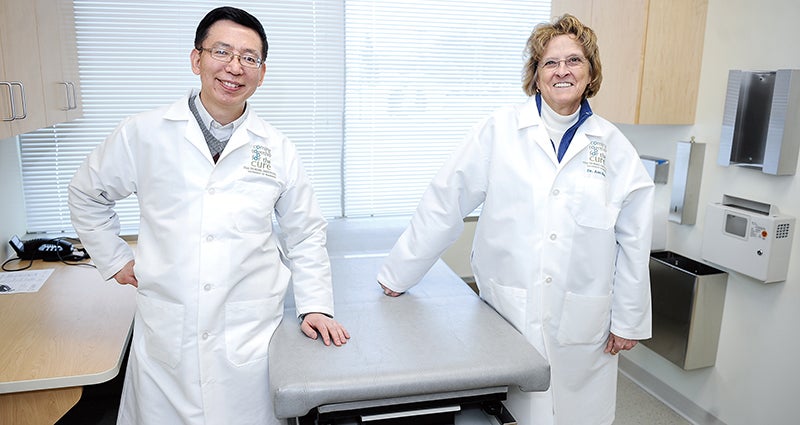The Hormel Institute: New clinic will play critical role in skin cancer treatment
Published 9:01 am Tuesday, February 27, 2018

- The Hormel Institute Executive Director Dr. Zigang Dong and Associate Director Dr. Ann Bode stand in one of the new examination rooms at the dermatology clinic in the Institute. Eric Johnson/photodesk@austindailyherald.com
The scientists at The Hormel Institute University of Minnesota have been well-known as leaders in the study of skin cancer — and now, the institute will play a critical role in the hands-on treatment of those cancers.
Plans, in partnership with the University of Minnesota Medical Center for Dermatology and the Hormel Foundation, are to open a dermatology clinic at the institute.
The clinic will provide a long-anticipated second-step in realizing the Institute’s vision of not only conducting valuable research, but also conducting the clinical trials to test the research.
“We are very excited,” said the Hormel Foundation President Gary Ray. “It is a critical path we’ve entered into at the institute, to take that research and prove it is valid, to have that capability. In the long term, it will also give us an opportunity to commercialize some of that work, obtaining patents, and taking it out onto the market.”

Progress 2018: This story, and much more, can be found in our annual Progress edition, on shelves now.
The Institute is well-positioned for that work and provides a valuable service at the same time, said Dr. Zigang Dong, executive director of the institute.
“We are very advanced” in skin cancer research, he said; having patients on site provides a valuable service in an area that has few options for skin cancer treatment. Most of the state’s clinics are located in the Twin Cities, and the nearest to Austin is in Rochester.
“There is a huge need for it,” agreed Dr. Ann M. Bode, associate director of the institute.
The clinic, expected to open later this year, will be operated from the east side of the institute, in offices first created with this possibility in mind when the institute was expanded in 2016.
Some minor remodeling will take place before the clinic opens. This opening would mark the sixth such clinic operated by the University.
The clinic will include a patient waiting room, receptionist room, two clinic rooms for seeing patients, a physician office and storage/support rooms.
In the beginning, the clinic will be staffed two days a week, and then five, as the operation ramps up.
Once the clinic, staffed by dermatologists from the University of Minnesota, is up and running full-time, plans are to conduct clinical trials there.
“That is the long-term goal; we believe in a few years,” Bode said.
Eventually, there may even be a larger facility built, on land owned by the institute, adjacent to the main building, Ray said, whose focus will be solely on clinical trials.
Providing a clinic in this area meets a need that is highest in Minnesota, said Dong. The state leads the nation in skin cancer occurrence, he added. A large Scandinavian population – which has light skin – has combined with a cultural wish to tan skin. The result is a high incidence of the cancer, since light-skinned people have little pigment in their skin to ward off a burn from ultraviolet rays, which, when it begins to damage the DNA in skin cells, can lead to cancer.
“Incidences of most cancers are declining,” said Dong. “But skin cancer is on the rise. The incidence of skin cancer alone encompasses breast, prostate, lung and colon cancer combined.”
“And while not usually fatal, there is a huge morbidity rate,” said Bode, adding annual treatment costs average over $8 billion. Treatment can sometimes result in disfigurement.

The new dermatology clinic at The Hormel Institute will play a critical role in the treatment of skin cancer. Eric Johnson/photodesk@austindailyherald.com
“We have been world leaders in skin cancer research,” said Gail Dennison, head of public affairs at the institute. “Now, we’re actually translating this to human beings; this is very much a historic plan for the institute, in its 75th year.”
Bode said the partnership with the University “has been great,” adding that staff there are handling budgeting, certifications, and outfitting of the clinic.
“We are very excited,” said Dong. “This is something that we can provide locally, and there is such a great need.”
The institute has been long recognized for its skin cancer research. In 2013, a research team at institute, led by Dong, discovered that an anticancer agent in milk thistle significantly restricted the growth of melanoma, a deadly form of skin cancer afflicting millions worldwide.
That work was featured in the May 2013 edition of Cancer Prevention Research, a publication by the American Association for Cancer Research, a leading cancer research journal. Their study found silybin weakened melanoma growth.
Several breakthroughs have occurred just in the past year at the institute. Scientists have been recognized for ground-breaking research in leukemia, ovarian cancer, cancer biology, and prostate cancer, with awards, grants and recognition in research publications.
In September 2017, the institute co-hosted the eighth China-U.S. Forum on Frontiers of Cancer Research and the fifth Zhengzhou International Cancer Forum in Zhengzhou, Henan, China. The quest to accelerate answers to cancer was the mission of the international conference that draws hundreds of researchers from around the world.





